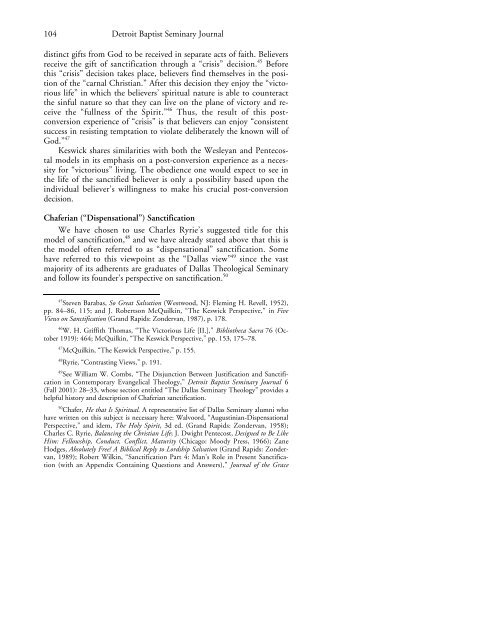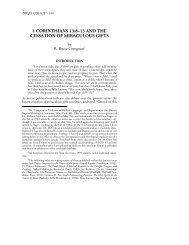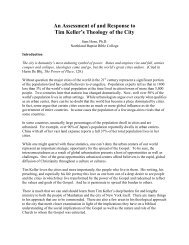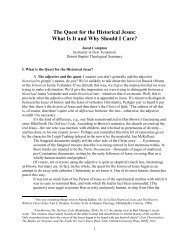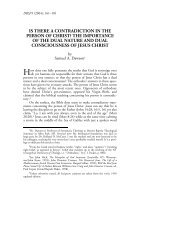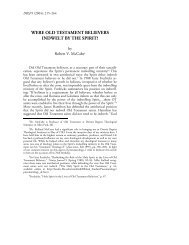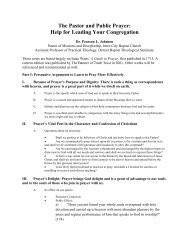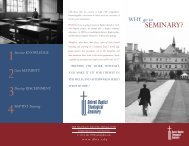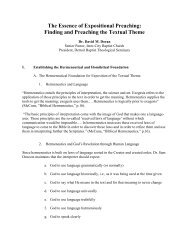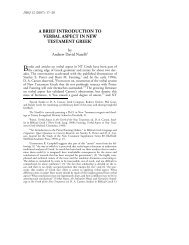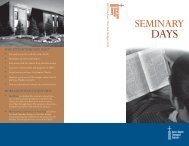Dispensational Sanctification: A Misnomer - Detroit Baptist ...
Dispensational Sanctification: A Misnomer - Detroit Baptist ...
Dispensational Sanctification: A Misnomer - Detroit Baptist ...
You also want an ePaper? Increase the reach of your titles
YUMPU automatically turns print PDFs into web optimized ePapers that Google loves.
104 <strong>Detroit</strong> <strong>Baptist</strong> Seminary Journal<br />
distinct gifts from God to be received in separate acts of faith. Believers<br />
receive the gift of sanctification through a “crisis” decision. 45 Before<br />
this “crisis” decision takes place, believers find themselves in the position<br />
of the “carnal Christian.” After this decision they enjoy the “victorious<br />
life” in which the believers’ spiritual nature is able to counteract<br />
the sinful nature so that they can live on the plane of victory and receive<br />
the “fullness of the Spirit.” 46 Thus, the result of this postconversion<br />
experience of “crisis” is that believers can enjoy “consistent<br />
success in resisting temptation to violate deliberately the known will of<br />
God.” 47<br />
Keswick shares similarities with both the Wesleyan and Pentecostal<br />
models in its emphasis on a post-conversion experience as a necessity<br />
for “victorious” living. The obedience one would expect to see in<br />
the life of the sanctified believer is only a possibility based upon the<br />
individual believer’s willingness to make his crucial post-conversion<br />
decision.<br />
Chaferian (“<strong>Dispensational</strong>”) <strong>Sanctification</strong><br />
We have chosen to use Charles Ryrie’s suggested title for this<br />
model of sanctification, 48 and we have already stated above that this is<br />
the model often referred to as “dispensational” sanctification. Some<br />
have referred to this viewpoint as the “Dallas view” 49 since the vast<br />
majority of its adherents are graduates of Dallas Theological Seminary<br />
and follow its founder’s perspective on sanctification. 50<br />
45 Steven Barabas, So Great Salvation (Westwood, NJ: Fleming H. Revell, 1952),<br />
pp. 84–86, 115; and J. Robertson McQuilkin, “The Keswick Perspective,” in Five<br />
Views on <strong>Sanctification</strong> (Grand Rapids: Zondervan, 1987), p. 178.<br />
46<br />
W. H. Griffith Thomas, “The Victorious Life [II.],” Bibliotheca Sacra 76 (October<br />
1919): 464; McQuilkin, “The Keswick Perspective,” pp. 153, 175–78.<br />
47<br />
McQuilkin, “The Keswick Perspective,” p. 155.<br />
48 Ryrie, “Contrasting Views,” p. 191.<br />
49<br />
See William W. Combs, “The Disjunction Between Justification and <strong>Sanctification</strong><br />
in Contemporary Evangelical Theology,” <strong>Detroit</strong> <strong>Baptist</strong> Seminary Journal 6<br />
(Fall 2001): 28–33, whose section entitled “The Dallas Seminary Theology” provides a<br />
helpful history and description of Chaferian sanctification.<br />
50 Chafer, He that Is Spiritual. A representative list of Dallas Seminary alumni who<br />
have written on this subject is necessary here: Walvoord, “Augustinian-<strong>Dispensational</strong><br />
Perspective,” and idem, The Holy Spirit, 3d ed. (Grand Rapids: Zondervan, 1958);<br />
Charles C. Ryrie, Balancing the Christian Life; J. Dwight Pentecost, Designed to Be Like<br />
Him: Fellowship, Conduct, Conflict, Maturity (Chicago: Moody Press, 1966); Zane<br />
Hodges, Absolutely Free! A Biblical Reply to Lordship Salvation (Grand Rapids: Zondervan,<br />
1989); Robert Wilkin, “<strong>Sanctification</strong> Part 4: Man’s Role in Present <strong>Sanctification</strong><br />
(with an Appendix Containing Questions and Answers),” Journal of the Grace


